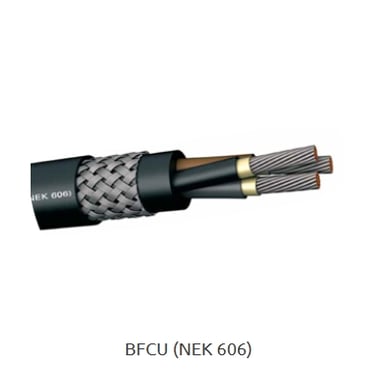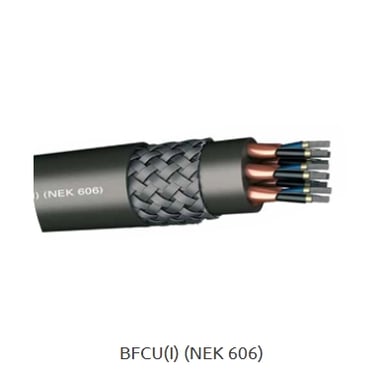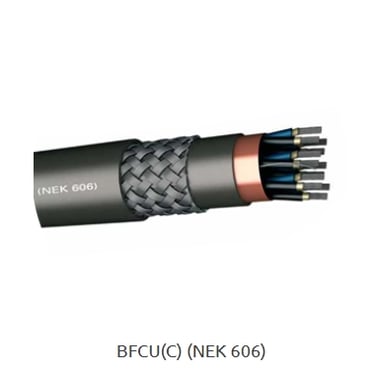NEK 606 Offshore Cables Explained: BFCU, BFCU(I), and BFCU(C) for Marine Power and Signal Systems
Explore NEK 606 certified offshore cables including BFCU, BFCU(I), and BFCU(C) for marine power, instrumentation, and communication. Compare specifications, fire resistance, and ideal applications in harsh offshore environments.
BLOGS
6/4/20259 min read


Introduction: The Critical Foundation of Offshore Operations
The offshore environment presents some of the most challenging conditions imaginable for electrical infrastructure. Picture massive oil platforms battling corrosive salt spray, drilling vessels enduring extreme temperature fluctuations, and floating production units subjected to constant mechanical stress from ocean swells. In these harsh conditions, electrical cables serve as the invisible lifelines that keep critical systems operational.
When cables fail in offshore environments, the consequences cascade rapidly. A single cable failure can trigger costly production shutdowns, compromise safety systems, delay project timelines, and damage corporate reputations. Consider that offshore downtime can cost operators between $50,000 to $500,000 per day, making cable reliability not just a technical consideration, but a fundamental business imperative.
This is where NEK 606 compliant cables emerge as the gold standard for offshore applications. The BFCU, BFCU(I), and BFCU(C) series represent engineered solutions specifically designed to withstand the unique challenges of marine environments while delivering uncompromising performance. These cables don't just meet basic electrical requirements—they provide the foundation for operational excellence and long-term return on investment in some of the world's most demanding applications.
Understanding NEK 606: The Norwegian Standard That Became Global
Origins and Global Recognition
NEK 606 originated as a Norwegian standard developed specifically for the demanding conditions of North Sea oil and gas operations. What began as a national standard has evolved into the internationally recognized benchmark for offshore cable performance. This standard addresses the unique combination of environmental, safety, and operational challenges that conventional marine cables simply cannot handle.
The standard's global adoption reflects its practical effectiveness. When major offshore operators consistently specify NEK 606 compliance, they're drawing on decades of field experience that demonstrates the standard's ability to reduce maintenance costs, minimize downtime, and enhance overall project reliability.
Critical Performance Parameters
NEK 606 establishes rigorous requirements across multiple performance dimensions that directly impact offshore operations. Understanding these parameters helps decision-makers appreciate why compliant cables command premium pricing while delivering superior long-term value.
Fire Performance Requirements
Fire safety in offshore environments involves unique considerations beyond those found in terrestrial applications. The standard mandates fire retardancy compliance with IEC 60332, ensuring that cables resist flame propagation even when exposed to hydrocarbon fires. More critically, fire resistance per IEC 60331 ensures that essential circuits maintain integrity during fire events, allowing emergency systems to function when they're needed most.
The Low Smoke Halogen Free (LSHF) requirement, verified through IEC 61034 and IEC 60754 testing, addresses the confined nature of offshore installations. When fires occur on platforms or vessels, toxic smoke and halogen gases can quickly overwhelm enclosed spaces, making evacuation impossible and damaging sensitive electronic equipment. LSHF cables minimize these risks by producing minimal smoke and no toxic halogen gases when exposed to fire.
Environmental Resilience Standards
Offshore cables face exposure to drilling muds, hydrocarbons, chemicals, and ultraviolet radiation that would rapidly degrade conventional cables. The SHF MUD resistance requirement, tested per IEC 60092-359, ensures cables maintain their properties even after prolonged exposure to the aggressive chemical mixtures used in drilling operations.
Oil and chemical resistance protects against the lubricants, hydraulic fluids, and process chemicals common in offshore operations. UV resistance prevents degradation of exposed cable sections, particularly important for topside installations on platforms and vessels.
Mechanical Integrity Specifications
The dynamic nature of offshore installations subjects cables to constant mechanical stress. Vibration from machinery, movement from ocean swells, and thermal cycling from temperature variations create fatigue conditions that challenge cable construction. NEK 606 addresses these through impact resistance, abrasion resistance, and vibration fatigue requirements that ensure cables maintain electrical integrity throughout their service life.
The BFCU Series: Engineered Solutions for Specific Applications
While all BFCU variants meet NEK 606 requirements, each serves distinct functional roles in offshore electrical systems. Understanding these differences enables optimal cable selection for specific applications, balancing performance requirements with project economics.



BFCU (NEK 606): The Foundation of Offshore Power Distribution
The standard BFCU cable serves as the workhorse for fixed power and control installations throughout offshore facilities. Its construction reflects a careful balance of performance, reliability, and versatility that makes it suitable for the majority of offshore electrical applications.
Technical Construction Details
The cable begins with electrolytic tinned stranded copper conductors manufactured to IEC 60228 Class 2 specifications, with Class 5 available for applications requiring enhanced flexibility. The tinning process provides corrosion resistance essential in marine environments, while the stranded construction offers mechanical flexibility during installation.
Each conductor receives a mica tape separator that serves as a fire barrier, maintaining circuit integrity even when the primary insulation degrades under fire conditions. The halogen-free HEPR (Hard Ethylene Propylene Rubber) insulation provides excellent electrical properties while meeting environmental safety requirements.
The cable's protective system consists of halogen-free bedding compound, galvanized steel wire braid armor for mechanical protection, and an outer sheath of SHF2 material (with SHF MUD available for enhanced chemical resistance). This multi-layer approach ensures comprehensive protection against the various threats present in offshore environments.
Performance Characteristics
Operating across a temperature range of -15°C to +90°C (with -40°C to +90°C available on request), the BFCU cable accommodates the thermal variations common in offshore operations. The 0.6/1 kV voltage rating with 3.5 kV test voltage provides adequate margin for most power distribution applications, while the 8x diameter minimum bending radius facilitates installation in confined spaces.
Application Scope
BFCU cables excel in power distribution systems, lighting circuits, motor control applications, and general electrical installations across platforms, FPSOs (Floating Production Storage and Offloading units), and marine vessels. Their robust construction makes them particularly suitable for applications where mechanical protection is paramount, such as equipment rooms, machinery spaces, and areas subject to physical impact.
BFCU(I) (NEK 606): Precision Signal Transmission for Critical Systems
The individually screened BFCU(I) cable represents the premium solution for applications where signal integrity cannot be compromised. Its sophisticated construction addresses the electromagnetic compatibility challenges inherent in complex offshore installations.
Advanced Screening Technology
The defining characteristic of BFCU(I) cables lies in their individual pair or triad screening system. Each conductor pair or triad receives its own electrolytic copper-coated polyester tape screen with 100% coverage, plus a dedicated tinned copper grounding wire. This individual screening approach creates isolated signal paths that virtually eliminate crosstalk between circuits.
The screening effectiveness becomes critical in offshore environments where high-power equipment, variable frequency drives, and radio communications create complex electromagnetic field patterns. Without proper screening, sensitive instrumentation signals can become corrupted, leading to measurement errors, control system malfunctions, and potentially dangerous operational conditions.
Construction Sophistication
Beyond the screening system, BFCU(I) cables incorporate several design features that optimize signal transmission. Conductors are arranged in twisted pairs or triads, with these elements then twisted concentrically to minimize electromagnetic coupling. The halogen-free EPR or HEPR insulation provides consistent dielectric properties across the operating temperature range.
The cable maintains the same protective outer construction as the standard BFCU, including galvanized steel wire armor and SHF2/SHF MUD outer sheath, ensuring that the sophisticated internal construction remains protected from environmental threats.
Critical Applications
BFCU(I) cables serve as the nervous system for high-precision sensor networks, critical data acquisition systems, and sensitive control loops where signal accuracy directly impacts operational safety and efficiency. They're essential for SCADA (Supervisory Control and Data Acquisition) systems, process control instrumentation, high-speed data transmission, and telemetry applications.
In practical terms, these cables ensure that pressure sensors accurately report well conditions, temperature measurements remain precise for process control, and communication systems maintain clear signals for coordination between offshore installations and onshore facilities.
BFCU(C) (NEK 606): Cost-Effective Collective Protection
The collectively screened BFCU(C) cable provides an economical solution for applications requiring electromagnetic protection without the complexity of individual screening. This approach offers a practical balance between performance and cost for specific offshore applications.
Collective Screening Approach
Rather than screening individual conductor pairs, BFCU(C) cables employ a single overall screen that protects the entire core bundle from external electromagnetic interference. This electrolytic copper-coated polyester tape screen with 100% coverage, combined with a tinned copper grounding wire, provides effective protection against external EMI sources while allowing some level of interaction between internal circuits.
The collective screening approach proves particularly effective when circuits carry related signals or when the application can tolerate minor levels of crosstalk. The simplified construction reduces manufacturing complexity and material costs while maintaining the essential protective features required for offshore service.
Targeted Applications
BFCU(C) cables excel in general communication lines, intercom systems, less sensitive instrumentation circuits, and non-critical data links where overall EMI protection suffices. They're particularly suitable for applications such as public address systems, general monitoring circuits, and communication networks where signal integrity requirements are moderate.
These cables also serve well in retrofit applications where budget constraints limit options but external interference protection remains necessary for reliable operation.


Strategic Selection Criteria for Offshore Projects
Application-Specific Analysis
Successful cable selection begins with a thorough analysis of each application's specific requirements. Power-critical applications, such as emergency systems and main power distribution, demand the robust mechanical protection of BFCU cables. Signal-critical applications, particularly those involving process control or safety systems, typically require the superior EMI protection of BFCU(I) cables.
The key lies in understanding that different areas of the same facility may have vastly different requirements. Control rooms with sensitive electronics may need individually screened cables, while general lighting circuits can operate reliably with standard power cables.
Risk Assessment Framework
Electromagnetic interference sources vary significantly across offshore installations. Areas near high-power motor drives, welding equipment, or radio transmitters create challenging EMI environments that may necessitate individually screened cables. Conversely, areas with minimal EMI sources may operate successfully with collectively screened or unscreened cables.
Environmental exposure levels also influence selection. Areas exposed to drilling muds or aggressive chemicals require SHF MUD outer sheaths, while standard SHF2 sheaths suffice for less challenging environments.
Regulatory Compliance Considerations
Offshore installations must satisfy multiple regulatory frameworks, including flag state requirements, classification society standards, and international maritime conventions. Major classification societies such as DNV, ABS, and Lloyd's Register maintain specific requirements for cable installations that influence selection criteria.
Understanding these requirements early in the design process prevents costly specification changes during later project phases and ensures smooth approval processes with regulatory authorities.
Lifecycle Cost Analysis
While NEK 606 compliant cables command premium pricing compared to standard marine cables, their superior performance characteristics typically deliver lower total cost of ownership. The extended service life, reduced maintenance requirements, and minimized downtime risk often justify the initial investment premium within the first few years of operation.
Consider that a single cable failure requiring vessel mobilization for repair can cost more than the initial price difference between standard and premium cables for an entire installation. This economic reality makes quality cable selection a strategic investment rather than a cost center.
Frequently Asked Questions
Q: What makes NEK 606 cables different from standard marine cables?
A: NEK 606 cables meet significantly more stringent requirements for fire performance, environmental resistance, and mechanical durability than standard marine cables. They're specifically engineered for the harsh conditions and safety requirements of offshore oil and gas operations, where cable failure can have catastrophic consequences.
Q: When should I specify BFCU(I) cables over BFCU(C) cables?
A: Choose BFCU(I) cables when signal integrity is critical to operation or safety, such as process control systems, precision instrumentation, or high-speed data transmission. The individual screening virtually eliminates crosstalk and provides superior EMI protection. BFCU(C) cables suffice for general communication applications where moderate levels of interference won't compromise system function.
Q: Can these cables operate in subsea applications?
A: The BFCU series is designed for fixed installations in air-filled environments, not direct subsea immersion. For subsea applications, specialized subsea cables with different construction and materials are required.
Q: What's the significance of the SHF MUD option?
A: SHF MUD outer sheaths provide enhanced resistance to drilling muds and hydrocarbons commonly encountered in drilling operations. This option extends cable life and maintains performance in areas where exposure to these aggressive chemicals is likely.
Q: How do I determine the appropriate voltage rating for my application?
A: The BFCU series operates at 0.6/1 kV, suitable for most offshore power distribution applications. For higher voltage requirements, other cable series may be necessary. Consult with cable specialists to ensure proper voltage rating selection.
Q: What installation considerations are specific to these cables?
A: Maintain minimum bending radii (8x diameter for BFCU, 10x for BFCU(I) and BFCU(C)), ensure proper grounding of screens, and use appropriate cable glands designed for the specific cable construction. Proper installation is crucial for achieving the intended performance characteristics.
Conclusion: Strategic Cable Selection for Operational Excellence
The selection of appropriate NEK 606 compliant cables represents a strategic decision that influences operational reliability, safety performance, and project economics throughout the offshore installation's service life. The BFCU series provides engineered solutions that address the unique challenges of offshore environments while delivering the performance characteristics essential for successful operations.
Understanding the distinct capabilities of BFCU, BFCU(I), and BFCU(C) cables enables project teams to optimize their selections, matching cable performance to application requirements while managing project costs effectively. The investment in quality cables that meet NEK 606 standards pays dividends through reduced maintenance, minimized downtime, and enhanced operational safety.
As offshore operations continue to push into more challenging environments and embrace increasing levels of automation and digitalization, the importance of reliable cable infrastructure will only grow. By selecting appropriate NEK 606 compliant cables and working with knowledgeable suppliers, offshore operators can build the electrical infrastructure foundation necessary for successful long-term operations.

